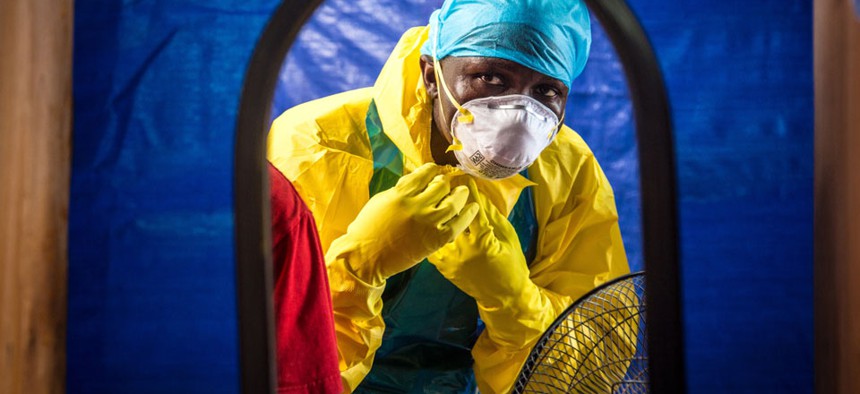Take a First Look at the Next Generation Ebola-Protection Suit

A healthcare worker dons protective gear before entering an Ebola treatment center in Freetown, Sierra Leone. Michael Duff/AP File Photo
The two biggest issues with past versions were the tendency for workers to overheat and the high risk of contamination when removing the suit.
AUSTIN, Texas—Perhaps the most surprising and important product debuting at SXSW Interactive this year is a personal protective equipment (PPE) prototype for health care workers dealing with Ebola, a tangible result of the U.S. government adapting the culture of innovation and design thinking so key in the startup world.
This morning, a team from the U.S. Agency for International Development demonstrated the traditional Ebola suit and the new suit in a preview for Quartz. (The suit is being shown to the public for the first time today at 3:30 p.m. at the JW Marriott.) The unlucky Alma Chapa, an adviser to USAID, wore the hot, stuffy old suit, taunted by an iced Starbucks coffee that she was not able to drink due to her facemask.
The two biggest issues with past PPEs were the tendency for workers to overheat and the high risk of contamination when removing the suit. Even as we sat in an air-conditioned hotel, Chapa’s goggles were fogging up and she was visibly uncomfortable after a half hour. The traditional Ebola suit is made up of many parts; the one worn by Chapa is typical of Doctors Without Borders’ outfits. A yellow coverall, topped by a Tyvek hood, a breathing mask and goggles, two sets of gloves, plus a heavy-duty splash guard, takes two people and about 20 minutes to put on. Every bit of skin has to be covered, and the suit is taped at the wrists and ankles. That means the suit also takes about 20 minutes to take off — after merely 45 to 60 minutes of wearing it, lest the health care worker overheat — and that must be done solo. “You’re at risk of heat stroke. The doctors have to calculate how much time they have enough time to get out of the suit,” says Wendy Taylor, director of the Center for Accelerating Innovation & Impact at USAID, and suit removal is when there’s the greatest risk of Ebola exposure.

Another issue with old suits is an effect called respirator waterboarding, where the sweating medical worker saturates the breathing mask, which then feels like drowning. “Just the pressure of glasses on your nose is an annoyance, like having a pebble in your shoe,” Chapa says. “Breathing through the mask feels normal but restrictive. For me, there’s also panic because I’m claustrophobic. Then add that to the stress and fear and heat.”
The only part of the worker visible is the eyes, and sometimes not even then if fog sets in, so doctors tend to write their names on their hoods so others can identify them. The entire outfit costs on average about $70—the boots, aprons and goggles can be used again after being dipped in bleach and air-dryed, but the rest is burned.
The new suit—designed by the Johns Hopkins Center for Bioengineering Innovation and Design and Jhpiego, a global health organization and Hopkins affiliate, and demonstrated at SXSW by Matt Petney, a JHU biomedical engineer—is one piece, with improved vision and ventilation and a quick removal process.
Read the rest at Quartz.
NEXT STORY: The Military's New Bid to Protect Your Data





